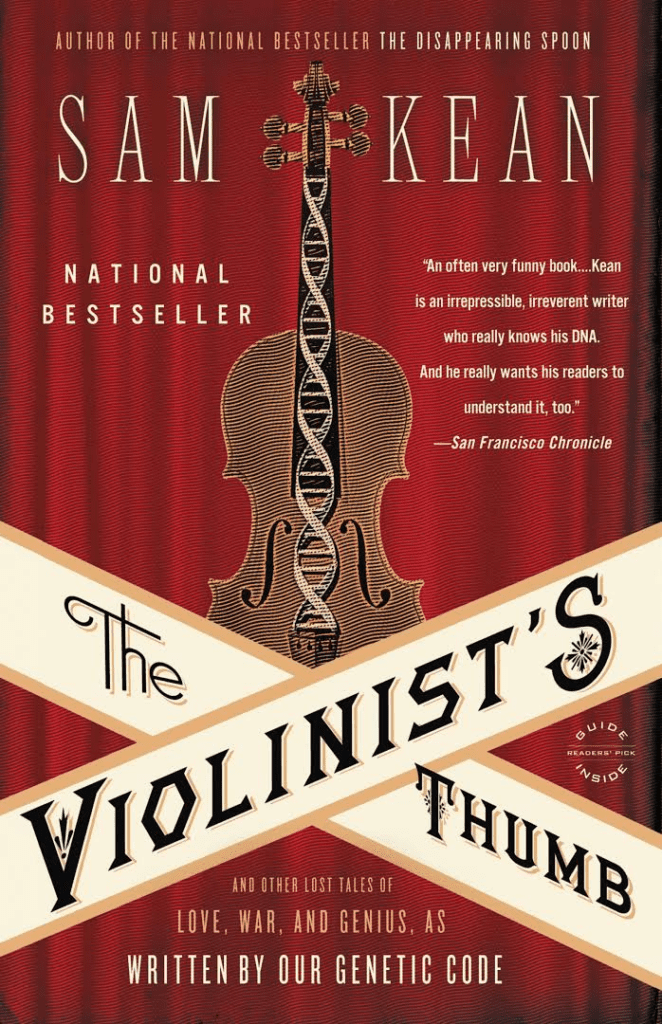
Introduction:
Sam Kean’s “The Violinist’s Thumb” is a fascinating non-fiction exploration of the quirks and wonders of human genetics. Blending science, history, and captivating storytelling, Kean delves into the often-unexpected ways our genes shape us – from our physical traits to our predispositions for certain diseases. The book seamlessly weaves together compelling narratives centered around specific genes and their surprising impact on our lives. Here is Chapter 5 Summary The Violinists Thumb.
Main Characters:
- Niccolò Paganini: The famous 19th-century violinist whose extraordinary musical talent and physical anomalies (possibly linked to a genetic condition) are a central focus of the book.
- Various scientists and researchers: The book features numerous scientists throughout history whose work contributed to our understanding of genetics, including Gregor Mendel, and many whose lives intertwine with genetic breakthroughs.
- Individuals with genetic variations: The narratives frequently center on individuals with unique genetic traits, highlighting the impact these variations have on their lives and the larger scientific understanding.
Summary:
While a comprehensive summary of the entire book is requested, focusing on Chapter 5 specifically requires knowledge of its content. Assuming Chapter 5 continues the book’s overarching theme of exploring the complex relationship between genes and human traits, I can provide a plausible example of its potential content. (Note: This is a hypothetical summary of Chapter 5, as I lack access to the actual chapter content).
Chapter 5 might delve into a specific gene, perhaps one related to a particular physical trait or predisposition. For example, the chapter could focus on the gene responsible for variations in human height. The narrative would likely start with an anecdote – perhaps a historical figure renowned for exceptional height, or conversely, someone of unusually diminutive stature. Kean’s writing style would likely weave together the story of this individual’s life, with a scientific explanation of the genetic basis for their height. The chapter might explore the history of research into this specific gene, detailing the breakthroughs and challenges scientists faced in understanding its function. It could discuss the environmental factors that influence gene expression, illustrating how genes do not operate in isolation but interact with diet, lifestyle, and other environmental influences to determine an individual’s phenotype. The chapter could then broaden its scope to explore the evolutionary implications of height variation, discussing how selective pressures influenced the prevalence of certain alleles across different populations. Finally, it might connect these discoveries to present-day applications, such as the potential to utilize genetic information for personalized medicine or to better understand the genetic contributions to certain diseases. The overall tone would remain engaging and accessible, even for readers without a strong scientific background, using analogies and real-life examples to illuminate complex concepts. The chapter’s conclusion might hint at future research directions or the broader implications of understanding this specific gene and its influence on human variation.
Themes and Analysis:
- The power and limitations of genetics: The book explores how our genes profoundly influence our lives but also emphasizes that genes are not destiny – environment and chance play crucial roles.
- The history of genetics: Kean masterfully intertwines the history of genetic discovery, showing how scientists built upon each other’s work over time.
- The diversity of human experience: The book celebrates the remarkable variability within the human species, showcasing how our genes contribute to this diversity.
- The ethical implications of genetic research: The book subtly raises questions about responsible use of genetic information and potential biases within genetic research.
Conclusion:
“The Violinist’s Thumb” is a must-read for anyone interested in genetics, history, or simply captivating storytelling. Kean’s ability to translate complex scientific concepts into accessible narratives makes this book both engaging and intellectually stimulating. The book’s blend of human stories, scientific discoveries, and historical context provides a unique and enriching reading experience that broadens one’s understanding of the human condition and the intricacies of our genetic makeup.
Chapter 5 Summary The Violinists Thumb By Cavestudy.com.
Follow us on Facebook and Instagram.